Bagshot Farm, Wairarapa
Bagshot is a sheep and beef hill country property nestled in Whangaehu Valley, 15 minutes from Masterton in the Wairarapa. It has been under the ownership and operation of Michael and Kate Tosswill since February 2018.
The 586 hectare farm encompasses 543 effective hectares, including 125 hectares of cultivatable terrain and 418 hectares of medium to steep hill country. The remainder is in conservation-focused areas like QEII blocks, native bush, and wetlands, showcasing their commitment to environmental preservation.
Video
Download this story
Download a copy of Bagshot Farm's story here [PDF, 684 KB] .
About the farm
Bagshot land area (ha)
|
Enterprise |
Land area (ha) |
|
Hill country |
418 |
|
Cultivatable land |
125 |
|
Mānuka |
4 |
|
Wetland |
6 |
|
Non-productive (races, drains) etc |
33 |
|
Total |
586 |
Livestock numbers and production
|
2018 |
2022 |
Future |
|
|
Effective ha |
552 | 543 | 501 |
|
% effective |
94% |
92% |
85% |
|
Breeding ewes |
2606 | 2340 | 2170 |
|
Breeding cows |
137 | 103 | 65 |
|
Pasture kg DM/ha |
7017 | 7031 | 7150 |
|
Kg product/ha |
215 | 251 | 259 |
|
SU/ha |
11.3 | 11.5 | 11.0 |
|
Gross margin ($/ha)
|
$710 |
$1112 |
$1174 |
What changes have been made?
Significant changes have been enacted on Bagshot, driven by a commitment to enhance sustainability and productivity.
Over the past five years, 10 hectares have been allocated to the establishment of natives, poplars, and wetlands, with an additional 4 hectares to mānuka and another 4 hectares to wetland preservation planned.
There is also a significant reduction in the use of nitrogen fertiliser, from 44.3 kg N/ha per annum to 16.7 kg N/ha.
The introduction of 34 hectares of pine trees on the lowest productive land further emphasises this progressive shift towards sustainability.
In the future, the Tosswills are aiming for a farm model that encompasses 501 hectares for effective grazing, 34 hectares for production forestry, and 18 hectares for diverse land uses, totalling 15 percent of the farm area.
A significant aspect of the changes involves an intensified focus on improving reproductive efficiency and performance within both the sheep and cattle systems.
A key aim for the farm is to optimise lamb survival rates and overall breeding efficiencies, like optimal mature adult size (for lower maintenance feeding) and high-performance hogget and heifer mating (creating product in the first year).
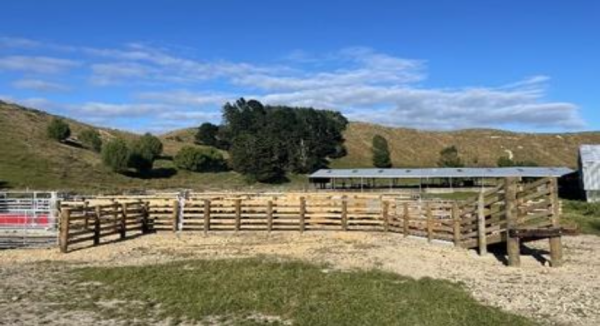
Another aim is to cultivate and provide high quality feed for optimal utilisation and growth rates which mixed with good management return a higher level of production. This creates a more balanced and resource-efficient farming approach while reducing the environmental impact of the system as a whole.
Why were the changes made?
Bagshot's comprehensive changes stem from a commitment to balance ecological preservation with enhanced productivity. Their mission statement underscores their commitment to nurturing the land for the generations to come.
Michael and Kate blended expert advice with their own observations to make decisions about integrated planting. They evaluated the marginal areas, weighed up financial gains against environmental impacts, and prioritised choices that align with their values, even if they're not the easiest or most lucrative.
The farm's comprehensive farm environment plan, developed in 2019, formalises their proactive steps towards reducing environmental impact, while also outlining areas for continuous enhancement.
GHG modelling method
The farm was modelled in Farmax for the three years being analysed. The same price files were used across all models for consistency.
What have been the impacts of the changes?
Figure 1: GHG emissions (T CO2e/ha)
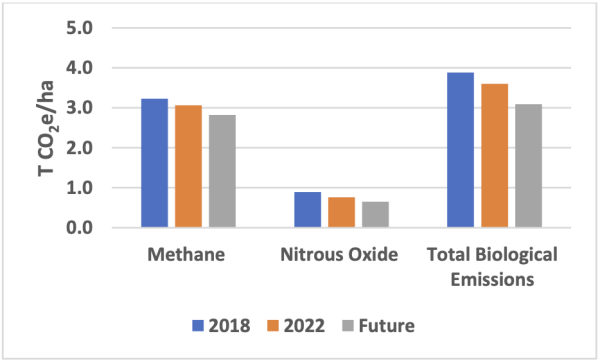
As shown in Table 2 below, the farm is planning to achieve some major reductions in GHG emissions including a 12 percent reduction in total emissions and a 24 percent reduction in emission intensity (more product for less emissions).
Key changes driving the outcomes in the table are and less ground in pastoral grazing, reduced nitrogen fertiliser, less livestock, and improved feed conversion.
Table 2: Per hectare emissions and emission intensity
| 2018 | 2022 | Future | Change | |
|
Methane (T CO2e/ha) |
3.22 | 3.06 | 2.99 |
-7% |
|
Methane (kg CH4/ha) |
128.9 | 122.4 | 119.4 | -7% |
|
Nitrous oxide (T CO2e/ha) |
0.96 | 0.77 | 0.68 | -30% |
|
Total biological emissions (T CO2e) |
2311 | 2117 | 2025 | -12% |
|
Emission intensity (kg CO2e/kg per kg product)
|
19.5 | 15.5 | 14.8 | -24% |
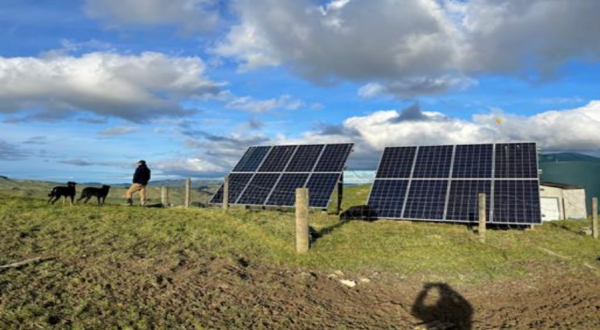
What process did they go through to make the changes?
Michael and Kate’s journey of transformation blended strategic planning and collaboration.
Their relationship with the Greater Wellington Regional Council has played a huge part in these changes, with the council providing advice, assisting with planning and implementation, and providing access to funding.
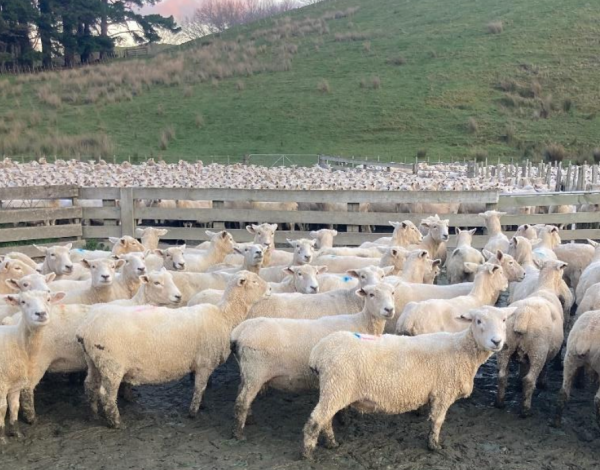
Farmax modelling was used to calculate greenhouse gas emissions, guiding decisions aligned with both ecological and economic objectives.
Livestock systems were optimised, resources accurately allocated, and breeding strategies refined for efficiency.
Where to from here?
Michael and Kate are engaging in an accreditation journey for their sustainable grazing practices through the Savory Institute’s regenerative agriculture model.
This initiative not only promotes ecological progress and soil health but also offers access to product premiums. These premiums encompass a range of items, from lamb pelts to new “regen” boot lines, pet food products, and wool contracts.
They are also planning to further strengthen their environmental efforts by planting more poplar poles, fencing more waterways, and expanding native plantings.
Future strategies include the adoption of advanced fertilisation and seed coating technologies to minimise waste and optimise resource utilisation.
Combining these actions with greenhouse gas calculations and a comprehensive whole farm plan, Michael and Kate are well-equipped to strategically execute their plans and navigate forthcoming environmental regulations while extracting maximum value from their products.
What drives or constrains change?
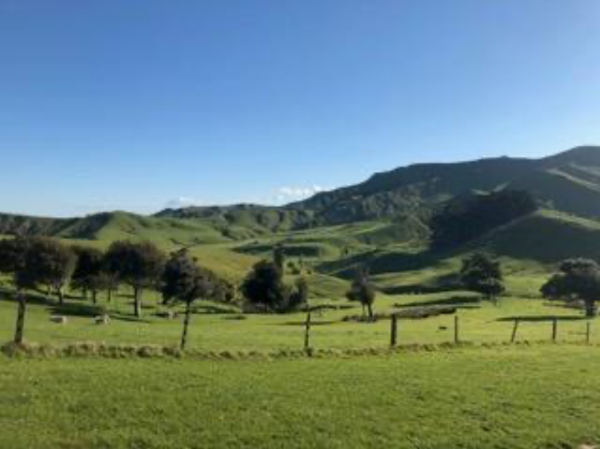
Change is propelled by a blend of internal aspirations and external pressures. The drive for growth and progress, coupled with market shifts, technological advancements, and societal concerns, all contribute.
The partnership with the Greater Wellington Regional Council has been a positive influence on change. Having a strategic framework, as evidenced in the farm environment plan, clear goals, and an ability to adapt to changes, ensures good progress.
What are they doing to ensure climate resilience for Bagshot?
Michael and Kate are taking proactive measures to enhance their farm's ability to handle climate changes.
• Transforming unproductive land into wetlands, native areas, and carbon forestry.
• Employing advanced techniques to nurture soil health and adopting precision methods for fertilisation and planting are integral parts of their strategy.
• Participating in programmes that reward sustainable farming practices and build financial resilience alongside climate resilience. For example, farm assurance programmes that qualify for premiums for product or reduced costs like interest rates.
These combined efforts are bolstering the farm's capacity to withstand climate uncertainties, ensuring its productivity and sustainability in the face of changing environmental conditions.
What advice do they have for other farmers?
Create a team of people with different areas of expertise to add valuable advice and support throughout the process.
• Use tools available to you to analyse changing scenario’s and make calculated decisions. Tools such as Farmax modelling have helped significantly in Bagshot system development.
• Utilise regional councils or other support services to help with knowledge sharing and funding options.
• Be open minded to all options available and the range of benefits they can provide.

